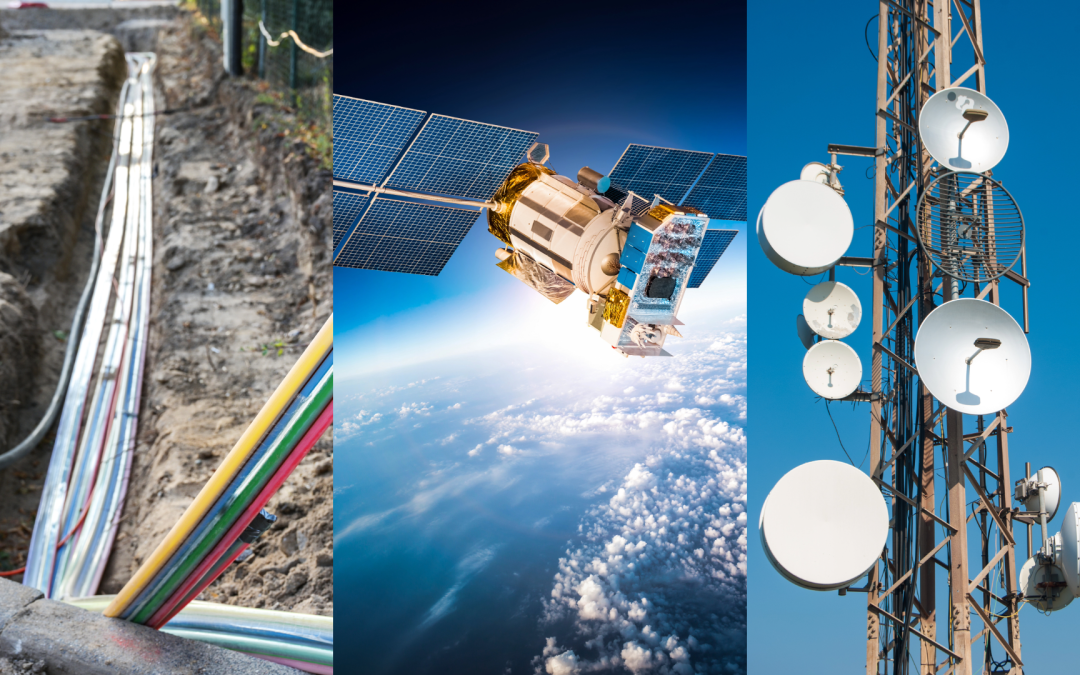Choosing the right home internet provider is crucial for staying connected, whether you’re streaming movies, working remotely, or gaming online. With different types of internet services available, it’s important to understand how each one works and how they impact performance.
In this guide, we’ll break down the key differences between Fiber, Fixed Wireless, and Satellite Internet to help you decide which option best suits your needs.
1. Fiber Internet: The Gold Standard for Speed and Reliability
How It Works
Fiber-optic internet transmits data using light signals through ultra-thin glass strands, allowing for blazing-fast speeds and low latency.
Pros
✅ Fastest Speeds – Speeds can reach up to gigabit levels (1 Gbps or more).
✅ Low Latency – Perfect for gaming, video calls, and real-time applications.
✅ Reliability – Not affected by weather or physical obstructions.
Cons
❌ Limited Availability – Fiber isn’t available everywhere, especially in rural areas.
❌ Higher Cost – Installation and monthly fees can be more expensive than other options.
Best For:
🏠 Urban and suburban households that need high-speed, reliable internet for streaming, gaming, and working from home.
2. Fixed Wireless Internet: A Reliable Alternative for Rural Areas
How It Works
Fixed wireless internet uses radio signals from a nearby tower to connect your home to the web. Unlike mobile data, it requires a fixed antenna on your property for a stable and consistent connection.
Pros
✅ Faster Than Satellite – Speeds often reach 100 Mbps or more, depending on location.
✅ Lower Latency – Performs better than satellite for gaming, video calls, and VPNs.
✅ No Data Caps (With Some Providers) – Unlike satellite, some fixed wireless plans offer unlimited data.
Cons
❌ Line of Sight Required – Obstructions like trees or buildings can impact performance.
❌ Availability – Only available near wireless towers, which can be limited in some areas.
Best For:
🏠 Rural and suburban users looking for a fast and more stable alternative to satellite.
3. Satellite Internet: The Last Resort for Remote Areas
How It Works
Satellite internet beams a signal from a satellite in Earth’s orbit to a dish installed at your home. This option is often the only choice for those living in remote or rural locations.
Pros
✅ Available Almost Everywhere – Works in even the most remote areas.
✅ No Need for Infrastructure – Doesn’t rely on cables or cell towers.
Cons
❌ High Latency – Slower response times due to the long distance signals travel (bad for gaming and video calls).
❌ Slower Speeds – Usually capped at 100-200 Mbps.
❌ Data Caps & Throttling – Many providers limit data usage, reducing speeds after a certain threshold.
❌ Expensive Plans – Often costs more than fixed wireless for lower speeds and reliability.
Best For:
🏠 Remote users with no access to fiber, cable, or fixed wireless internet.
Which Internet Type Should You Choose?
| Feature | Fiber | Fixed Wireless | Satellite |
| Speed | 🚀 Fastest (Up to 10 Gbps) | ⚡ 100Mbps -1GB | 🛰️ Slower (Up to 200 Mbps) |
| Latency | 🟢 Lowest (<10ms) | 🟡 Moderate (10-50ms) | 🔴 High (500+ms) |
| Availability | ❌ Limited to cities & suburbs | ✅ Available near towers | ✅ Available almost everywhere |
| Cost | 💲💲💲 Higher | 💲💲 Moderate | 💲💲💲 Expensive |
| Best For | Gaming, Streaming, Work-from-home | Homes needing stable internet for Gaming, Streaming, Work-from-home | Remote locations with no other options |
Final Verdict: Which One Should You Get?
- If fiber is available in your area, go for it – it’s the best choice for speed, reliability, and performance.
- If you live in a rural area without fiber, fixed wireless is the next best option for decent speeds and low latency.
- Only choose satellite internet if you have no other options, as it comes with higher latency, data caps, and slower speeds.
Looking for high-speed fixed wireless internet in Arizona? Phoenix Internet offers unlimited data, fast speeds, and reliable service—perfect for rural and suburban areas! Check availability today!

